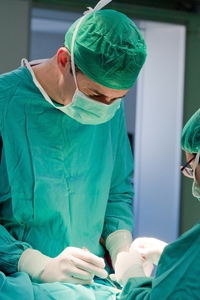Spleen Removal (Splenectomy)
 The surgical procedure to remove the spleen is a splenectomy.
The surgical procedure to remove the spleen is a splenectomy.
The spleen is an organ that helps fight infection and cleanses foreign substances from the blood, including worn-out blood cells.
A ruptured spleen, due to a severe abdominal injury, is the most common reason for undergoing a splenectomy.
Other reasons for a splenectomy may include: enlarged spleen (splenomegaly), some blood disorders, certain cancers, infection, cysts, or tumors.
Symptoms
Signs and symptoms of a ruptured spleen include:
- Severe abdominal trauma
- Pain in the upper left portion of the abdomen
- Tenderness when you touch the upper left portion of the abdomen
- Lightheadedness
- Confusion
In some cases, there are no symptoms associated with an enlarged spleen. However you may experience the following symptoms:
- Pain or fullness in the left upper abdomen that may spread to the left shoulder
- Feeling full without eating or after eating only a small amount
- Anemia
- Fatigue
- Frequent infections
- Easy bleeding
Preparing for your Splenectomy
Our staff will explain the procedure to you and answer any questions you might have prior to surgery. You may receive a physical examination, including blood and urine tests, to ensure you are in good health for the procedure.
Please make sure to bring a complete list of all medications and herbal supplements you are currently taking with you to your appointment.
Please let our staff know if you have any of the following conditions:
- Pregnant or suspect you are pregnant
- Allergic to medications, latex, tape, or anesthetics
- History of bleeding disorders or are taking a blood thinner, aspirin, or other medications that affect blood clotting
What to Expect
You will be asked to remove any jewelry or objects that interfere with the surgery as well as your clothing; you will be given a surgical gown to wear. A member of our staff will start an intravenous (IV) line in one of your arms.
The surgery is performed with the patient lying on their back while they are under general anesthesia. An anesthesiologist will monitor your vital signs including heart rate, blood pressure, breathing, and blood oxygen levels during the surgery.
Once you are unconscious, your surgeon begins the surgery using either a laparoscopic or open procedure.
In a splenectomy, an incision is made in the middle of the abdomen. Muscle and other tissue are moved aside to reveal your spleen, and then it will be tied off with sutures and removed. After the spleen has been removed, the incision will be closed.
Recovery
You may spend approximately one hour or longer in the recovery room before you are taken back to your room either in the ambulatory care unit or on the medical/surgical floor.
While in the recovery room, your surgeon usually meets with your family to let them know how you are doing and to answer any questions they may have. Your family will meet you in your room.
You must be alert, take fluids without vomiting, and urinate before discharge. Your nurse will give you written discharge instructions based on your surgeon's orders.
Do not drive or drink alcohol for 24 hours after your surgery. Patients cannot be discharged unaccompanied via taxicab or public transportation.
Please plan to have a competent caregiver available to stay with you and assist you the day and night of surgery.
At the time of discharge, your medications will be called into the pharmacy of your choice. If you have any questions or concerns during your stay, please ask your nurse.
Once you have been discharged, it is important to keep the incision clean and dry. Our staff will provide you with specific showering instructions.
Follow Up
Arrangements for a follow-up appointment with our staff will be made upon discharge.
